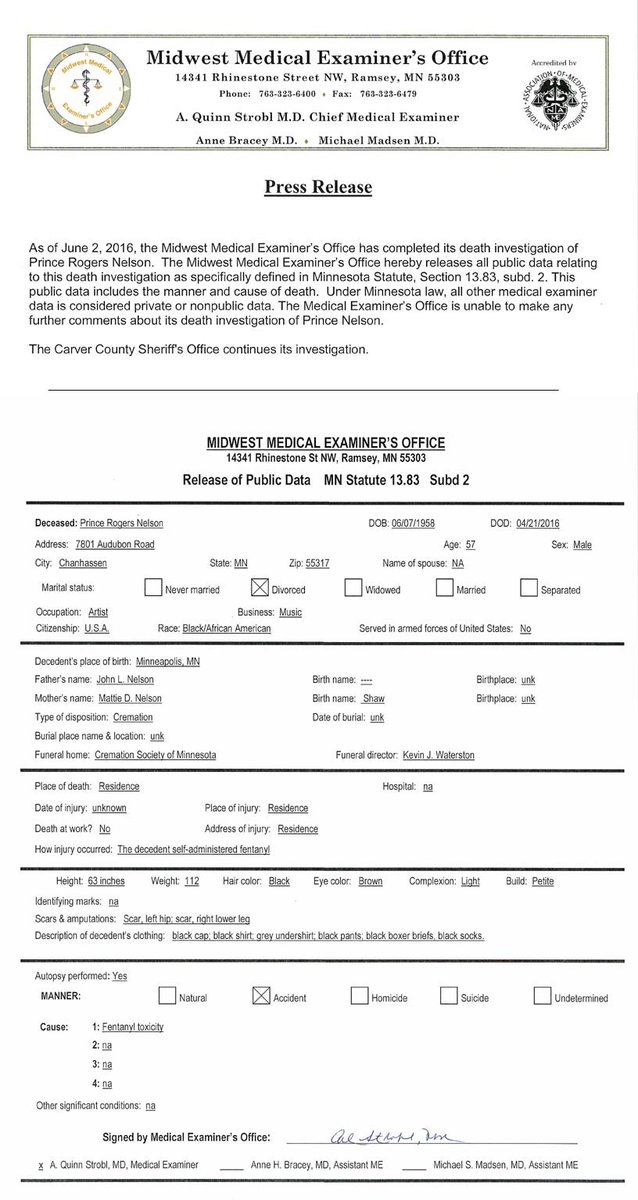Autopsy results released Thursday by the Midwest Medical Examiner’s Office confirmed that Prince died from an overdose of fentanyl, a type of synthetic opiate used to treat pain.
The report did not say how much of the drug the singer, whose given name was Prince Rogers Nelson, had in his system. “It’s 50 to 100 times more potent than morphine,” according to the Centers for Disease Control and Prevention. “It is prescribed in the form of transdermal patches or lozenges.” However, most recent cases of fentanyl-related harm, overdose and death in the U.S. are linked to illegally made fentanyl, the CDC says.
William Mauzy, an attorney for Howard Kornfeld, the founder and director of the Recovery Without Walls addiction center in Mill Valley, Calif., told reporters in May that Kornfeld’s son Andrew arrived at Prince’s compound in Minnesota with a small quantity of buprenorphine pills, used to treat pain and opioid addiction, but arrived shortly after the singer died. Opioids include hydrocodone (Vicodin), oxycodone (OxyContin, Percocet), morphine and codeine. The former are the most commonly prescribed for a variety of painful conditions, including dental and injury-related pain, according to the National Institute on Drug Abuse.
The percentage of American workers testing positive for prescription drugs has also risen over the last decade, according to more than 10 million workplace drug test results by Quest Diagnostics DGX, +1.22% a company that provides clinical laboratory tests. Among 53% of the working population, there were different drugs found in the system of American workers than what they’d been prescribed by doctors compared to just 28% in 2011, the data found. That includes opiates (pain relievers such as morphine, codeine, hydromorphone) and marijuana.
More people died from drug overdoses in the U.S. in 2014 than during any previous year on record, and more than half (61%) involved pain medication. Over 47,000 Americans died of a drug overdose, up 6.5% from 43,982 on the previous year, with 28,647 involving pain medication — three times the level in 2000, according to data released by the Centers for Disease Control and Prevention released earlier this year. There has been a 15-year increase in overdose deaths involving prescription opioid pain relievers, the CDC said.
“There’s a need for prescription drug monitoring in the nation,” says Leland McClure, medical science liaison of Medical Affairs at Quest Diagnostics in St. Louis. “We see misuse across all age groups, states and payer groups — whether people use Medicare, Medicaid or [private] insurance. Anyone can be at risk for misuse of these medications.” Employees provide a rich source of data on prescription and illegal drug misuse, even as some companies have caught flack for testing for drugs like marijuana, given its increased legalization.
Why the surge in pain medication misuse? People addicted to drugs are buying them on the street, as they’re often cheaper than other illegal drugs, and people with genuine need for pain medication leave drugs lying around or they develop an addiction to pain medication after being prescribed drugs for an injury or ailment, McClure says. The Partnership for Drug-Free Kids launched a “Mind Your Meds” campaign three years ago with the aim of preventing 500,000 teenagers from abusing medicines by 2017.
What’s more, the number of U.S. workers testing positive for amphetamines rose 7.2% year-over-year to 1.04% of the population in 2014 from 0.97% the year before, the latest data shows. Across all types, the positivity rate for amphetamines is now at its highest levels on record and the positivity rate for methamphetamine is at its highest level since 2007. (Amphetamines describe the category that includes both prescription amphetamine drugs like Adderall and methamphetamine, an illicit drug often known for being produced in clandestine labs.)



Комментариев нет:
Отправить комментарий